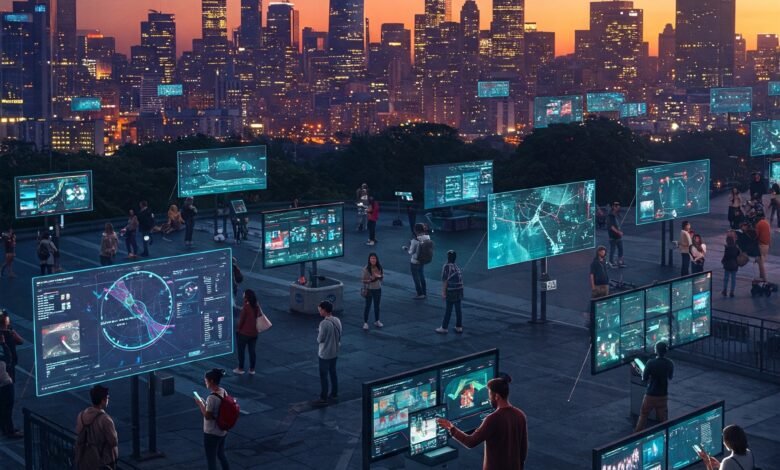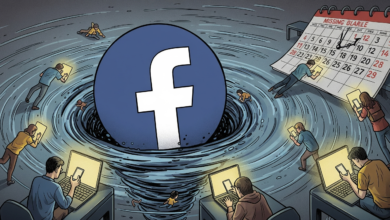The Impact of Technology on American Society

Introduction to Technology in Society
Technology, in its broadest sense, refers to the application of scientific knowledge and tools to solve problems and enhance human capabilities. This encompasses a wide array of forms, from traditional inventions like the wheel and the printing press to modern innovations such as smartphones, artificial intelligence, and biotechnology. Over the past few decades, American society has experienced an unprecedented acceleration in technological advancements, fundamentally transforming various aspects of daily life and reshaping the social fabric.
The rapid evolution of technology has been driven by significant breakthroughs in information and communication technology, computing power, and connectivity. The advent of the internet and mobile technologies has revolutionized the accessibility of information, enabling individuals to connect with others instantaneously, regardless of geographical distance. Social media platforms have further facilitated this connectivity, creating new modes of interaction and engagement among individuals, communities, and organizations.
In addition to enhancing communication, technology has dramatically impacted the economy, influencing the way businesses operate and consumers shop. E-commerce has surged, with online retail platforms offering convenience and a wider selection of products, thereby reshaping traditional retail. Automation and artificial intelligence have emerged as pivotal players in various industries, optimizing production processes and enhancing efficiency, albeit raising concerns about job displacement and workforce adaptation.
Beyond economic implications, technology has seeped into cultural practices, influencing art, entertainment, and education. Streaming services have altered the landscape of media consumption, while online learning platforms have made education more accessible. As technology continues to permeate every facet of American life, its multifaceted impacts demand thorough exploration and understanding, highlighting both the opportunities it presents and the challenges it poses to society.
Economic Transformations Driven by Technology
The American economy has undergone immense transformations due to the influence of technology. One of the most notable shifts is the emergence of the digital economy, which has profoundly altered traditional business models. E-commerce has become a cornerstone of economic activity, allowing consumers to shop for goods and services from the comfort of their homes, thus broadening access and convenience. This digital transition has enabled businesses to reach a global market, significantly increasing their customer base and potential revenue.
Moreover, there has been a marked shift from traditional manufacturing sectors towards technology-driven services. Industries such as healthcare, finance, and education have increasingly integrated advanced technologies, leading to enhancements in operational efficiency and client services. Automation and data analytics have allowed companies to streamline processes and make informed decisions based on real-time data. This evolution not only improves productivity but also shifts the skill requirements for the workforce, demanding more tech-savvy personnel capable of working in technology-rich environments.
The gig economy represents another critical development spurred by technological advancement. Platforms like Uber and TaskRabbit have revolutionized the way individuals seek employment, allowing for flexible job opportunities that cater to various needs and lifestyles. The gig economy has created new revenue streams for many, rendering traditional full-time employment models less dominant. However, this shift has also raised concerns regarding job security and benefits for workers who may not enjoy the protections offered to more traditional employees.
While technology drives innovation and economic growth, it can also displace workers in certain sectors as automation and artificial intelligence take over tasks previously performed by humans. The challenge for policymakers is to ensure that the workforce is equipped with the necessary skills to adapt to this rapidly evolving economic landscape. The impact of technology on the American economy is profound, shaping how we work, shop, and interact with one another.
Changes in Communication and Relationships
The advent of technology has significantly transformed the landscape of communication and interpersonal relationships in American society. One of the most notable changes is the rise of social media platforms such as Facebook, Twitter, and Instagram. These platforms have redefined the way individuals connect and interact with one another, making it possible to maintain relationships over vast distances. Friends and family members can share life updates almost instantaneously, which fosters a sense of closeness, even when physically apart. However, while these connections can be beneficial, they may also lead to superficial relationships characterized by a virtual presence rather than genuine emotional exchanges.
Instant messaging applications, like WhatsApp and Snapchat, have also revolutionized communication. With the ability to send quick messages, photos, and videos, these platforms facilitate immediate conversations, which can enhance feelings of connectedness. On the other hand, the constant accessibility brought about by these technologies can contribute to misunderstandings and miscommunications, as messages are often misinterpreted without the nuances of face-to-face interactions. Additionally, heavy reliance on digital communication may result in diminished interpersonal skills, making it challenging for individuals to engage effectively in real-world interactions.
Furthermore, video call applications such as Zoom and Skype have emerged as essential tools for maintaining personal and professional relationships. The ability to see and hear individuals in real-time can create a more intimate experience compared to traditional phone calls. This technology has proven especially vital during times of physical separation, such as during the COVID-19 pandemic, illustrating its role in preserving connections amid crisis. Nevertheless, the overuse of such technologies could lead to fatigue, commonly referred to as “Zoom fatigue,” undermining their intended purpose of fostering social bonds.
Education and Technology: A New Landscape
The integration of technology into education has fundamentally transformed the learning landscape in America. Online learning platforms have emerged as a critical resource, providing students with unprecedented access to educational materials and opportunities. As a result, the traditional classroom setting is being supplemented, or in some cases replaced, by digital environments that allow for flexible learning schedules and personalized experiences. This shift has become particularly pronounced in the wake of the global pandemic, which expedited the adoption of remote education solutions.
One significant enhancement brought about by technology is the availability of digital resources that cater to diverse learning needs. Educational software and online libraries offer a wealth of information at students’ fingertips, from e-books to interactive learning modules that adapt to individual learning speeds. This democratization of knowledge has proven essential in broadening access to quality education for students in underserved communities, ensuring that geographical and socioeconomic barriers are less daunting. However, while technology has the power to make education more inclusive, it also presents new challenges, particularly concerning the digital divide. Not all students have equal access to reliable internet and devices, which can exacerbate existing inequalities in educational attainment.
Moreover, the integration of technology in classrooms introduces both benefits and complexities for educators. Teachers must now balance traditional pedagogical methods with the demands of incorporating digital tools into their curricula, which can require significant training and adjustment. On one hand, these tools can facilitate more interactive and engaging learning experiences, fostering collaboration and communication among students. On the other hand, they can lead to distractions and require careful management to ensure that the focus remains on learning. As American society continues to navigate this evolving education landscape, the implications of technology’s role in learning remain a critical area for assessment and improvement.
Healthcare Advancements Through Technology
The healthcare sector has experienced transformative changes due to technological advancements, significantly improving healthcare delivery and patient outcomes. One of the most notable innovations is telemedicine, which has expanded access to care, particularly during the COVID-19 pandemic. Telemedicine allows patients to consult with healthcare professionals remotely, utilizing video conferencing and secure messaging systems. This approach not only minimizes the need for in-person visits but also enhances the convenience and efficiency of medical consultations, especially for those in rural or underserved areas.
Additionally, the implementation of electronic health records (EHRs) has revolutionized the way patient data is stored and accessed. EHRs facilitate better information sharing among healthcare providers, improving coordination and continuity of care. With real-time access to comprehensive patient information, healthcare professionals can make informed decisions quickly, leading to improved treatment outcomes and reduced medical errors.
Wearable health monitors, such as fitness trackers and smartwatches, have also gained traction in healthcare. These devices empower patients to take an active role in their health management by providing real-time data on vital signs, physical activity, and other health indicators. This continuous monitoring can lead to early detection of potential health issues and encourage healthier lifestyle choices, ultimately contributing to better overall health.
Furthermore, the incorporation of artificial intelligence (AI) in diagnostics and treatment represents a significant advancement in healthcare technology. AI algorithms can analyze vast amounts of medical data, assisting healthcare professionals in identifying patterns and making accurate diagnoses. In fields such as radiology and pathology, AI tools can improve the speed and accuracy of interpretations, thereby enhancing patient care. The ongoing integration of these technological innovations signifies a promising future for healthcare in America, with the potential for improved patient experiences and outcomes.
Cultural Shifts Induced by Digital Influence
The advent of technology has precipitated significant cultural transformations within American society, largely driven by the proliferation of digital media. The rapid expansion of the internet and mobile devices has led to an explosion of content available at consumers’ fingertips, thereby reshaping how individuals engage with diverse forms of media. As streaming services such as Netflix, Hulu, and Disney+ gain popularity, traditional television viewing habits have markedly changed. Audiences are transitioning from scheduled programming to on-demand consumption, empowering them to curate their own entertainment experiences. This shift not only affects viewing preferences but also significantly influences the kind of content that is produced, highlighting diverse voices and underrepresented narratives.
Moreover, technology has revolutionized consumer behavior by facilitating immediate access to products and services through e-commerce platforms. The increased reliance on online shopping has altered the retail landscape, compelling traditional businesses to adapt to the digital sphere. Engaging in online interactions, consumers now seek not only convenience but also authenticity and transparency from brands. Influencer marketing, a phenomenon amplified by social media, further demonstrates how technology shapes purchasing decisions and cultural norms. This trend emphasizes the power of peer recommendations and the influence of curated content on consumer preferences.
Cultural movements and trends are also being reshaped by digital platforms, which provide a space for marginalized groups to express their identities and advocate for social change. Social media has become a catalytic force, empowering individuals to mobilize and organize around critical issues, thus creating new cultural dialogues. The ability to share experiences and stories instantaneously has fostered a culture of immediacy and interconnectedness that transcends geographic boundaries. As technology continues to evolve, its impact on American culture will undoubtedly remain profound, driving further shifts in how society interacts, consumes, and engages with the world around them.
Privacy and Ethical Concerns
The rapid advancement of technology has significantly influenced American society, particularly concerning the issues of privacy and ethics. As the digital landscape evolves, the concern surrounding data security has escalated. Personal information, once considered private, is now frequently collected, analyzed, and utilized by corporations and governments alike. This collection not only raises questions about consent but also deepens fears regarding data breaches, unauthorized access, and potential misuse of personal data.
Surveillance has become another pressing concern in the technology-driven era. With the proliferation of smartphones, home assistants, and smart devices, citizens often unwittingly expose themselves to constant monitoring. This environment generates significant ethical dilemmas; individuals must balance the conveniences offered by technology with their right to privacy. While surveillance can enhance security, it simultaneously risks infringing on personal freedoms, prompting a growing debate on the ramifications of such monitoring practices.
Moreover, the role of big tech companies cannot be overlooked in the discussion of privacy and ethics. These corporations wield immense power, not only because of their capabilities to collect vast amounts of data but also due to their influence over public opinion and policy decisions. The ethical implications of their algorithms raise concerns about bias in automated decision-making processes, which can adversely affect marginalized groups. As algorithms dictate everything from hiring practices to criminal justice outcomes, transparency becomes crucial in ensuring that technology serves the greater good without perpetuating injustice.
As American society continues to navigate the complexities posed by technological advancements, it becomes increasingly vital to address the associated privacy and ethical concerns. Developing frameworks that prioritize data security, accountability from corporate entities, and fairness in algorithmic decisions can help mitigate the risks inherent in our technologically driven world.
Environmental Impact of Technology
The advancement of technology has brought profound changes to American society, and one of the most significant concerns is its environmental impact. As digital infrastructure continues to expand, it contributes notably to the carbon footprint. The data centers that store vast amounts of information require significant energy, often derived from non-renewable sources. This reliance on fossil fuels results in increased greenhouse gas emissions, exacerbating climate change. A thorough understanding of the environmental implications of technology is essential for mitigating its adverse effects.
Another pressing issue is the management of electronic waste (e-waste). As consumers upgrade their devices more frequently, the volume of discarded electronics has surged. According to recent statistics, millions of tons of e-waste are generated annually, containing harmful substances such as lead and mercury. Proper disposal and recycling of such materials are crucial to prevent pollution and protect environmental health. Efforts to improve e-waste regulations and encourage recycling initiatives can significantly reduce these environmental risks.
Despite these challenges, technology also plays a role in combating climate change. Innovations in renewable energy sources, such as solar and wind power, showcase how technology can offer sustainable alternatives to traditional energy generation. Moreover, advancements in energy-efficient devices contribute to reducing overall energy consumption. Technologies for monitoring environmental changes, such as satellite imagery and remote sensing, are instrumental in comprehending climate dynamics and informing policy decisions aimed at environmental protection.
To summarize, while the impact of technology on the environment presents several challenges—namely carbon emissions and e-waste—the same technology also provides tools and solutions that can help mitigate these issues. Balancing these effects is critical as society continues to navigate the complexities of technological advancement.
Looking Ahead: The Future of Technology in Society
The future of technology in American society is poised to bring transformative changes, driven by advancements in artificial intelligence (AI), automation, and sustainable practices. As technology continues to evolve, it is essential to anticipate how these developments will shape various aspects of daily life, the economy, and the environment.
One of the most significant trends is the rise of artificial intelligence, which has already begun to redefine sectors such as healthcare, finance, and transportation. AI systems are expected to perform increasingly complex tasks, enabling personalized healthcare solutions, enhancing financial analytics, and improving traffic management. As AI capabilities expand, societal adaptation will be necessary to address ethical considerations, such as privacy, bias, and job displacement. This will require collaboration among stakeholders, including policymakers, technologists, and community representatives, to develop frameworks that ensure equitable access and responsible deployment of AI technologies.
Automation, another pivotal component of the future technological landscape, has the potential to revolutionize manufacturing and service industries. With robots and intelligent systems taking on routine tasks, there is a growing concern about job security for many workers. However, this shift could also create new job opportunities in technology-driven fields, requiring a workforce adept in digital skills. To prepare for this transition, educational institutions and training programs must evolve to equip individuals with the competencies necessary for success in an automated economy.
Sustainability is increasingly becoming a focal point in technological innovation. As society grapples with climate change and resource depletion, technologies that promote renewable energy and reduce environmental footprints are gaining traction. From smart grids to efficient waste management systems, the integration of technology into sustainable practices will be crucial for fostering a healthier planet.
As we look ahead, it is evident that the future of technology in American society will necessitate careful consideration of its implications. Adapting to these changes will require a proactive approach that emphasizes collaboration, education, and sustainability, ensuring that technology serves as a force for positive societal transformation.






















